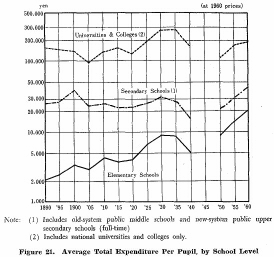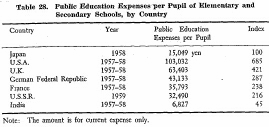| Home > Policy > White Paper, Notice, Announcement > White Paper > JAPAN'S GROWTH AND EDUCATION 1963 > CHAPTER |
||
Many factors such as teachers, facilities and equipment, teaching materials, etc., affect the contents of education, but all such factors are to a large extent expressed in the composite measure of average per-pupil cost of educational expenditure.
Average total educational expenditure per pupil, when examined by different levels of school, as shown in Figure 21, evidenced several distinct trends. Per-pupil costs of elementary schools advanced at a fairly continuous rate from 1890 to 1930, with a rather sharp decrease from then to 1940. Secondary school per pupil costs reached a peak in 1900 not again attained until 1960, plateauing at a fairly consistently low level from 1905 to 1920, followed by relatively low rates of increases through 1930. Unit costs of higher education dropped continuously from 1890 through 1905, regained the level of 1890 in 1915, and, after a slight drop in 1920, increased sharply to 1930. All per pupil costs dropped sharply from 1930 through 1940, except for a minor increase in higher education costs in 1935.
The yearly increase in the elementary school expenses provides the proof that in response to the quantitative spread of compulsory education the efforts had been made in the repletion of the education from qualitative viewpoint.
The main reason why the educational expenses per pupil of secondary level remained on the same level or decreased during the 50 years since 1890, is that as a result of the spread of secondary school education, the size of school and class was enlarged, which enabled t6 lower down the cost per pupil for the same service.
The decrease in the educational expenses per student for higher education immediately after the war was caused partly by the fact that appropriations for higher education did not keep pace with increasing enrollments, due to the higher priority given to financing the expansion of compulsory education (through the lower secondary school grades 7-9).
The following reasons also should not be overlooked. The first is that mainly because of the democratization of education and the resultant various social factors, the doors of university and college were opened to the public, their size was magnified and as a result the number of students per teacher greatly increased. The second is that after the war the difference between salaries and allowances of university professors and elementary school teachers became smaller for the former's salaries and allowances relatively lowered compared in the days prior to the war. The third is that as not only the old universities but also all colleges became universities under new educational system, physical conditions necessary for university education and research lag behind in some cases.

In the foregoing discussion, total educational expense has included three categories of expenditure: teachers' salaries, other current expense and capital outlay. Teachers' salaries includes salaries of all instructional and supervisory personnel; other current expense includes instructional supplies, operation and maintenance of tlae school plant, and auxiliary agencies such as school health, school meals and pupil transportation; while capital outlay includes costs of school buildings, sites and equipment.
Amounts in every category at elementary school level have been increasing. Above all the increase in "other current expense" is outstanding. That amounts in "teachers' salaries" have increased year after year to be seven times now as much as those in 1890. This is due to the fact that sufficient number of teachers is now maintained, the number of pupils per teacher decreased and tlae conditions for teaching service have been improved. (As to the basic data, refer to the tables in Appendix 3-1) The marked increase in "other current expense", particularly that after the war, is due to the over-all improvement of various conditions of elementary school and at the same time to the improved educational contents with the introduction of the new educational services, such as school lunch and school health. There is seen the marked increase also in the amount of "capital outlay" after the war, which proves a continuous effort in the consolidation and repletion of facilities and equipment.
Salaries of teachers of the old-system middle school remained on almost same level in the days prior to the war, but after the war those for the new-system upper secondary school increased as the result of the increase in the number of teachers and the improvement of the conditions for teaching service. Also "other current expense" has the tendency of increasing after the war, though there was no change during the days before the war. "Capital outlay" increased in 1900, which was the result of the enactment of the Regulations Concerning the Organization, Facilities and Equipment of Middle School of 1899, which provided the standard of facilities and equipment in middle schools. The facilities and equipment of upper secondary school have, as in the case of elementary school, been continuously improved after the war.
Expenditure for university and college increased in the period 1925-1935 during which university, college and higher professional school were expanded, but it decreased during tlae war and the post-war days. "Teachers' salaries" per student and "capital out1ay" per student have been increasing a little recently, but have not yet reached their level of the pre-war days. "Other current expense" per student decreased to the greater extent after the war, its amount is even in recent around one third of that in the days prior to the war and no marked increase has not yet been seen. In the contrast to the increase in the "teachers' salaries" per pupil for elementary school up to seven times as much as those in 1890, those for university and college have remained only 1.8 times as much as those in the same year, which is mainly because of rapid increase in the number of students per teacher after the war. Such situation will, together with other factors, have to be taken into consideration for improvement. The decrease in "other current expense" for university and college, which is in striking contrast to the increase in the expense for elementary and secondary schools in 1960, respectively 16 and 2.6 times as much as those in 1890, shows that the improvement of physical conditions of university and college has been lagging behind.
Per pupil costs of education in Japan are considerably lower than those of other progressive countries. As shown in Table 28, the per pupil cost of elementary and lower secondary schools of the U.S.A. are 6.8 times, of the United Kingdom 4.2 times, of the German Federal Republic 2.9 times, of France 2.4 times and of the U.S.S.R. 2.2 times as much as those of Japan. The differences between those of Japan and those of the countries are lessening but still remain great.
However, the national income per capita of the U.S.A. is 8.6 times, of the German Federal Republic 3.1 times, of France 3.8 times as great as that of Japan. The differences in educational costs are smaller than those in national income in these cases. In the case of the United Kingdom, however, the educational cost is 4.2 times that of Japan, but the national income is only 3.8 times that of Japan. Further effort should be made to increase the education expenses in Japan. The educational expenses per elementary school pupil have been increasing continuously since the quantitative diffusion of elementary school education completed in earlier days and the larger part of educational expenses was allotted to the qualitative development.
In the secondary education, because of the increase in the number of pupils as a result of the development of middle schools in tlae days prior to the war, the fund could hardly. be allotted to the qualitative improvement. After the war, however, the efforts have been directed to both quantitative development and qualitative improvement and the educational expenses per pupil have been increasing.
In the higher education, the educational expenses per student has decreased since the quantitative development was carried out too rapidly after the war. The increase in the educational expenses, in order to make qualitative improvement of higher education, will be the matter of most urgency in the future.

| Back to Top | MEXT HOME |